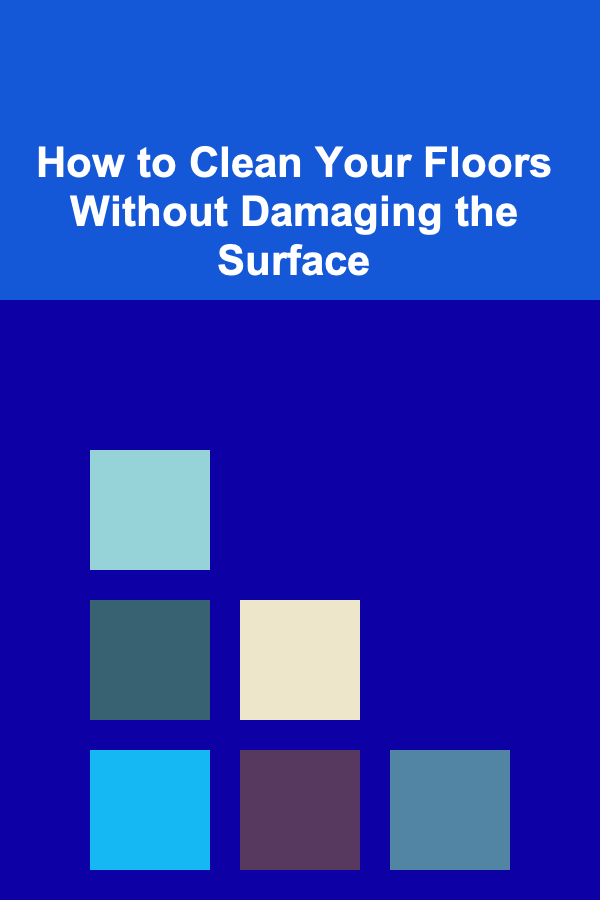
How to Clean Your Floors Without Damaging the Surface
ebook include PDF & Audio bundle (Micro Guide)
$12.99$11.99
Limited Time Offer! Order within the next:

Floor cleaning is one of those tasks that often feels like a never-ending cycle. Whether you have hardwood, tile, carpet, or laminate floors, cleaning them properly is crucial to maintaining their appearance and longevity. However, using the wrong cleaning methods or products can lead to surface damage, discoloration, or a reduced lifespan of the floor. Cleaning your floors without causing harm requires the right techniques, products, and understanding of your floor's material.
In this guide, we'll explore how to clean different types of floors without damaging them. We'll also cover the best cleaning tools and tips to help you maintain your floors effectively and safely.
Understanding Floor Materials
Before diving into specific cleaning techniques, it's important to understand the different types of flooring and their unique needs. Each material has its own sensitivities, and the wrong cleaning method could cause irreversible damage. Here are some common floor materials and their characteristics:
Hardwood Floors
Hardwood floors are elegant and timeless, but they are sensitive to moisture. Excessive water can cause warping, swelling, or cracking. Additionally, certain cleaning agents can strip the protective finish on hardwood, leading to dullness or discoloration.
Tile Floors
Tile floors are durable and versatile, but the grout lines between tiles can trap dirt and moisture. Porous tiles, like natural stone (e.g., marble, granite, or slate), may absorb cleaning solutions or water, leading to staining and weakening.
Laminate Floors
Laminate floors mimic the look of wood or stone but are not as durable. They are moisture-resistant but not waterproof. Using too much water or harsh chemicals can cause the laminate to warp or peel.
Vinyl Floors
Vinyl floors are known for their affordability and resilience, but they can become scratched or discolored if harsh cleaners or abrasive tools are used. They are moisture-resistant, but excessive water can still cause damage over time.
Carpet Floors
Carpets require regular cleaning to avoid accumulating dirt and allergens. However, too much water can lead to mold growth, and abrasive cleaners can damage the fibers. Proper vacuuming, spot cleaning, and occasional deep cleaning are necessary to keep carpets in good condition.
Understanding the properties of each material will help you select the appropriate cleaning methods to protect your floors while achieving a clean, fresh appearance.
General Tips for Floor Cleaning
Regardless of the type of flooring you have, there are some general principles that can help you clean effectively without causing damage:
- Avoid Excessive Moisture: For most floors, excessive moisture can lead to water damage. Use only the amount of water needed and dry the floor immediately after cleaning. Microfiber mops are ideal because they hold moisture without saturating the surface.
- Use Mild, pH-Neutral Cleaners: Harsh chemicals can strip finishes, dull surfaces, or leave residues. Opt for pH-neutral cleaners or specialized floor cleaners that are safe for your flooring type.
- Test New Products: Before using a new cleaning product or tool, test it on a small, inconspicuous area to ensure it doesn't cause any damage or discoloration.
- Vacuum Regularly: Dust, dirt, and debris can scratch your floors when dragged across the surface. Vacuum or sweep frequently to avoid this issue. For carpeted areas, invest in a vacuum with a gentle setting for cleaning floors without damaging fibers.
- Use Soft Cloths or Mops: Abrasive cloths or brushes can scratch delicate floors. Use microfiber cloths or soft mops to gently clean the surface without causing harm.
- Work in Small Sections: When cleaning large areas, work in small sections. This allows you to focus on one spot at a time and ensures that cleaning solutions are not left on surfaces for too long.
Now, let's take a look at cleaning methods for specific floor types.
How to Clean Hardwood Floors Without Damaging the Surface
Hardwood floors are prized for their natural beauty, but they require special care. The primary concern with hardwood floors is moisture, as excessive water can cause the wood to expand, warp, or discolor.
Step 1: Sweep or Vacuum
Before cleaning your hardwood floors, remove any dirt, dust, or debris. Use a soft-bristle broom or a vacuum with a hardwood floor setting to prevent scratches. Avoid using a vacuum with a beater bar, as this can damage the finish.
Step 2: Choose the Right Cleaning Solution
For regular cleaning, use a cleaner specifically designed for hardwood floors. If you prefer a homemade solution, mix a few drops of mild dish soap with warm water. Never use harsh chemicals, such as ammonia or bleach, as they can damage the finish and weaken the wood over time.
Step 3: Mop the Floor
Use a microfiber mop to clean the floor. Dip the mop into the cleaning solution, then wring it out so it's damp but not wet. Mop the floor in small sections, always following the grain of the wood. Avoid using too much water, and make sure the floor dries quickly to prevent moisture from seeping into the wood.
Step 4: Dry the Floor
After mopping, use a clean, dry microfiber cloth to wipe away any excess moisture. This will help prevent water damage and keep the floor looking shiny.
Step 5: Regular Maintenance
To protect your hardwood floors, consider applying a wood polish or protectant every few months. This will help maintain the shine and provide an additional layer of protection against dirt and moisture.
How to Clean Tile Floors Without Damaging the Surface
Tile floors are known for their durability and ease of maintenance, but cleaning the grout lines and ensuring that the tiles remain free of stains requires some attention to detail.
Step 1: Sweep or Vacuum
Begin by sweeping or vacuuming the floor to remove dirt and debris. Pay special attention to the grout lines, as dirt can build up here and cause discoloration. A vacuum with a soft brush attachment works well for tiles and grout.
Step 2: Choose the Right Cleaner
For regular cleaning, a pH-neutral cleaner works best. If you need to clean grout or stains, use a grout cleaner or a homemade paste of baking soda and water. Avoid using acidic cleaners (like vinegar) on grout, as they can cause damage.
Step 3: Mop the Floor
Mop the tile floor using a microfiber mop and your chosen cleaning solution. Ensure that the mop is only damp, not wet. Excessive water can seep into the grout lines and cause discoloration or weakening.
Step 4: Dry the Floor
After mopping, dry the floor with a soft cloth or towel to prevent water from seeping into the grout or tiles.
Step 5: Clean Grout
For grout stains, use a grout cleaner or the baking soda paste. Apply the paste to the grout lines, scrub with a soft brush, and rinse with warm water. Avoid abrasive brushes, as they can scratch the surface of the tiles.
Step 6: Regular Maintenance
To prevent dirt buildup in the grout lines, seal the grout periodically. This will protect it from stains and help keep your tiles looking new.
How to Clean Laminate Floors Without Damaging the Surface
Laminate floors are an affordable alternative to hardwood, but they can be easily damaged by moisture or harsh chemicals. Therefore, cleaning laminate requires a gentle touch.
Step 1: Sweep or Vacuum
Remove dirt and debris by sweeping or vacuuming the floor. Use a vacuum with a soft brush attachment to avoid scratches on the laminate.
Step 2: Choose the Right Cleaner
Opt for a laminate floor cleaner or a mild solution of dish soap and water. Avoid using waxes, polishes, or abrasive cleaners, as they can leave streaks or damage the laminate surface.
Step 3: Mop the Floor
Use a microfiber mop to clean the floor. Damp mop the surface in small sections, being careful not to saturate the floor with water. Wipe the floor immediately with a dry microfiber cloth to remove any excess moisture.
Step 4: Dry the Floor
After mopping, dry the laminate floor with a clean, dry cloth to prevent water damage.
Step 5: Regular Maintenance
For routine maintenance, use a dust mop or a dry microfiber cloth to keep the laminate floor free of dust and dirt. This will help reduce the need for deep cleaning and minimize potential damage.
How to Clean Vinyl Floors Without Damaging the Surface
Vinyl floors are durable and low-maintenance, but they can easily be scratched by abrasive tools or damaged by harsh cleaning agents. Here's how to clean them effectively:
Step 1: Sweep or Vacuum
Remove dirt and debris by sweeping or vacuuming the floor. Be sure to use a vacuum with a soft brush attachment to avoid damaging the surface.
Step 2: Choose the Right Cleaner
Use a pH-neutral cleaner designed for vinyl floors. Avoid using wax-based products, which can make the floor slippery or attract dirt. If you need to remove stains, try using a mild dish soap solution.
Step 3: Mop the Floor
Use a microfiber mop to clean the vinyl floor, being careful not to use too much water. Damp mop the surface and wipe dry immediately with a clean cloth.
Step 4: Dry the Floor
After mopping, make sure to dry the floor with a clean, dry microfiber cloth to prevent water from pooling in any cracks or edges.
Step 5: Regular Maintenance
Keep the floor clean by using a dust mop or vacuum regularly. This will help prevent dirt buildup and protect the floor from scratches.
How to Clean Carpet Floors Without Damaging the Surface
Carpet floors require regular cleaning to maintain their appearance and prevent the buildup of dirt and allergens. However, carpets are sensitive to water and cleaning agents, so it's important to follow the right steps.
Step 1: Vacuum Regularly
Vacuum the carpet at least once a week, or more often if you have pets or high foot traffic. Use a vacuum with a gentle setting to avoid damaging the carpet fibers.
Step 2: Spot Clean Stains
For spills and stains, blot the area with a clean cloth to absorb as much liquid as possible. Use a carpet cleaner specifically designed for your carpet type. Avoid using harsh chemicals or rubbing the stain, as this can push it deeper into the fibers.
Step 3: Deep Clean Periodically
Every few months, perform a deep clean using a steam cleaner or hire a professional service. This will help remove trapped dirt and allergens and restore the carpet's appearance.
Step 4: Dry the Carpet
After deep cleaning, ensure the carpet is thoroughly dried to prevent mold or mildew growth. Use fans or open windows to speed up the drying process.
Conclusion
Cleaning your floors without damaging the surface requires knowledge, the right tools, and careful attention to the specific needs of each floor type. By following the tips outlined in this guide, you can ensure that your floors remain beautiful and durable for years to come. Regular maintenance, combined with gentle cleaning methods, will help protect your floors and keep them looking their best.

How to Clean and Maintain Your Hardwood Floors
Read More
How to Create a Checklist for Decluttering Your Entryway: An Actionable Guide
Read More
How to Create a Cozy Reading Nook on a Budget
Read More
How to Maintain Your Home's Exterior Paint to Avoid Fading
Read More
How to Make Money Online as a TikTok Consultant: 10 Actionable Ideas
Read More
How To Visit a Craft Brewery for the First Time
Read MoreOther Products

How to Clean and Maintain Your Hardwood Floors
Read More
How to Create a Checklist for Decluttering Your Entryway: An Actionable Guide
Read More
How to Create a Cozy Reading Nook on a Budget
Read More
How to Maintain Your Home's Exterior Paint to Avoid Fading
Read More
How to Make Money Online as a TikTok Consultant: 10 Actionable Ideas
Read More